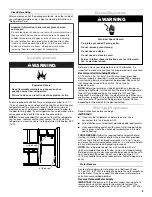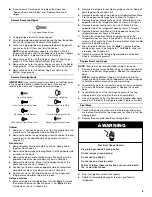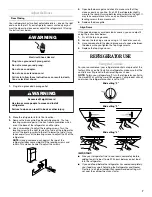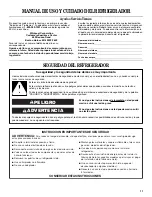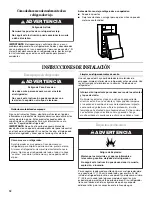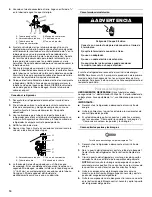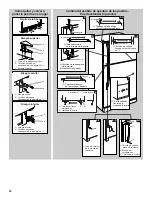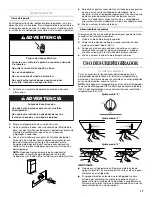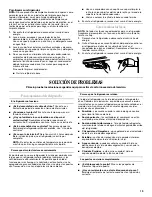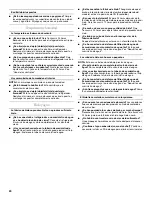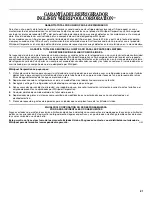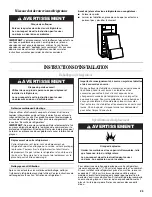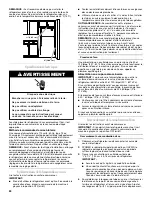
9
4. There is no need for routine condenser cleaning in normal
home operating environments. If the environment is
particularly greasy or dusty, or there is significant pet traffic in
the home, the condenser should be cleaned every 2 to
3 months to ensure maximum efficiency.
If you need to clean the condenser:
■
Remove the base grille.
■
Use a vacuum cleaner with a soft brush to clean the grille,
the open areas behind the grille and the front surface area
of the condenser.
■
Replace the base grille when finished.
5. Plug in refrigerator or reconnect power.
Changing the Light Bulbs
NOTE: Not all bulbs will fit your refrigerator. Be sure to replace the
bulb with one of the same size, shape, and wattage.
1. Unplug refrigerator or disconnect power.
2. Remove the bulb from behind the control panel in the
refrigerator or from behind the light shield in the freezer (on
some models). Replace it with a bulb of the same wattage.
3. Plug in refrigerator or reconnect power.
TROUBLESHOOTING
Try the solutions suggested here first in order to avoid the cost of an unnecessary service call.
Refrigerator Operation
The refrigerator will not operate
■
Power cord unplugged? Plug into a grounded 3 prong outlet.
■
Is outlet working? Plug in a lamp to see if the outlet is
working.
■
Household fuse blown or circuit breaker tripped? Replace
the fuse or reset the circuit breaker. If the problem continues,
call an electrician.
■
Are controls on? Make sure the refrigerator controls are on.
See “Using the Controls.”
■
New installation? Allow 24 hours following installation for the
refrigerator to cool completely.
NOTE: Adjusting the temperature controls to coldest setting
will not cool either compartment more quickly.
The motor seems to run too much
Your new refrigerator may run longer than your old one due to its
high-efficiency compressor and fans. The unit may run even
longer if the room is warm, a large food load is added, doors are
opened often, or if the doors have been left open.
The refrigerator seems noisy
Refrigerator noise has been reduced over the years. Due to this
reduction, you may hear intermittent noises from your new
refrigerator that you did not notice from your old model. Below are
listed some normal sounds with explanations.
■
Buzzing - heard when the water valve opens to fill the ice
maker.
■
Pulsating - fans/compressor adjusting to optimize
performance.
■
Hissing/Rattling - flow of refrigerant, movement of water
lines, or from items placed on top of the refrigerator.
■
Sizzling/Gurgling - water dripping on the heater during
defrost cycle.
■
Popping - contraction/expansion of inside walls, especially
during initial cool-down.
■
Water running - may be heard when water melts during the
defrost cycle and runs into the drain pan.
■
Creaking/Cracking - occurs as ice is being ejected from the
ice maker mold.
The doors will not close completely
■
Door blocked open? Move food packages away from door.
■
Bin or shelf in the way? Push bin or shelf back in the correct
position.
The doors are difficult to open
■
Gaskets dirty or sticky? Clean gaskets and contact surfaces
with mild soap and warm water. Rinse and dry with soft cloth.
Temperature and Moisture
Temperature is too warm
■
New installation? Allow 24 hours following installation for the
refrigerator to cool completely.
■
Door(s) opened often or left open? Allows warm air to enter
refrigerator. Minimize door openings and keep doors fully
closed.
■
Large load of food added? Allow several hours for
refrigerator to return to normal temperature.
■
Controls set correctly for the surrounding conditions?
Adjust the controls a setting colder. Check temperature in
24 hours. See “Using the Controls.”
There is interior moisture buildup
NOTE: Some moisture build-up is normal.
■
Humid room? Contributes to moisture build-up.
■
Door(s) opened often or left open? Allows humid air to enter
refrigerator. Minimize door openings and keep doors fully
closed.
1
2
4
5
WARMER
WARMER
COOLER
COOLER
RECOMMENDED
SETTING
RECOMMENDED SETTING
REFRIGERATOR
REFRIGERATOR
3
1
2
4
5
WARMER
WARMER
COOLER
COOLER
RECOMMENDED SETTING
RECOMMENDED SETTING
FREEZER
FREEZER
3
ALLOW 24 HOURS BE
TWEEN ADJUSTMENT
S
ALLOW 24 HOURS BETWEEN ADJUSTMENTS
3
3



